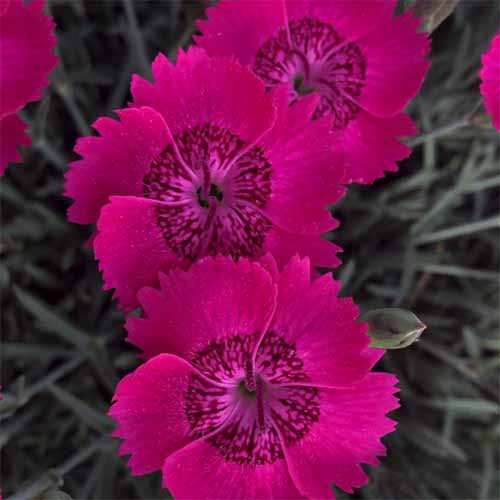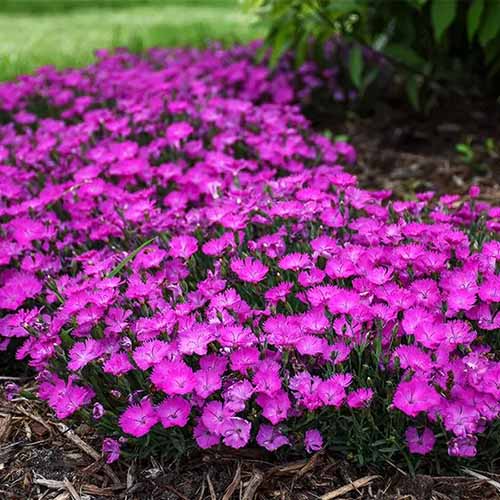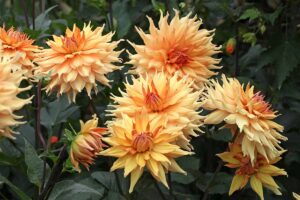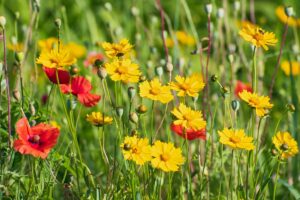Dianthus alpinus
A must-have for rock gardens, alpine pinks (Dianthus alpinus) are hardy perennials noted for their compact growth, sweetly spicy fragrance, and masses of brightly colored flowers.
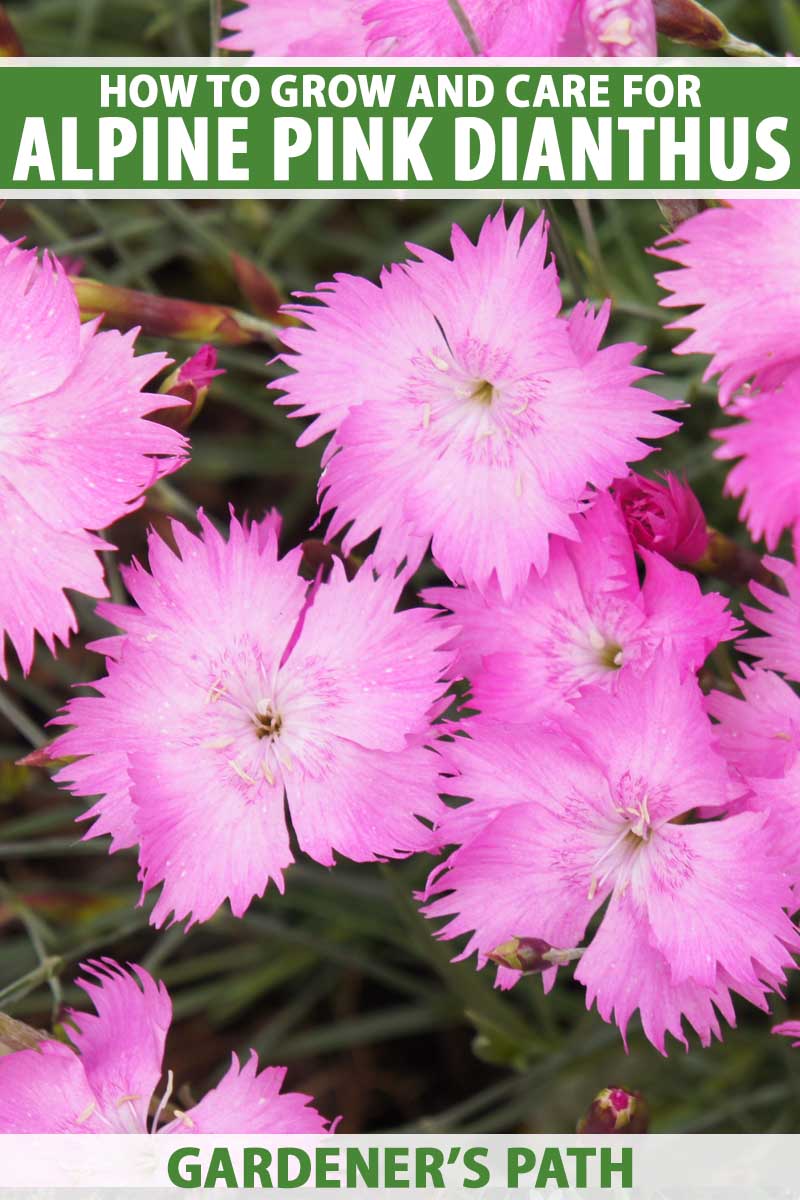
We link to vendors to help you find relevant products. If you buy from one of our links, we may earn a commission.
These evergreen plants are decked out with gorgeous, frosty blue-green foliage that forms dense cushions or mats, spreading out into an effective ground cover when mass planted.
With small, dainty flowers on wiry, branched stems and narrow, linear leaves, plants appear delicate but are in fact hardy and robust, with good resistance to cold, drought, heat, and salt.
A standout selection for alpine or gravel gardens, rockeries, and screes, alpine pinks are also well suited to growing in beds, borders, and containers, adding color and perfume over an extended season.
They’re also highly attractive to beneficial pollinators like bees and butterflies but are resistant to deer.
Colorful, fragrant, and hardy, these small plants deliver a big impact in any setting!
Let’s dig in now to learn about how to grow alpine pinks.
Here’s what we’ll cover:
What You’ll Learn
What Are Alpine Pinks?
Alpine pinks, D. alpinus, also known as rockery pinks, are a species of herbaceous perennials in the carnation family, Caryophyllaceae.
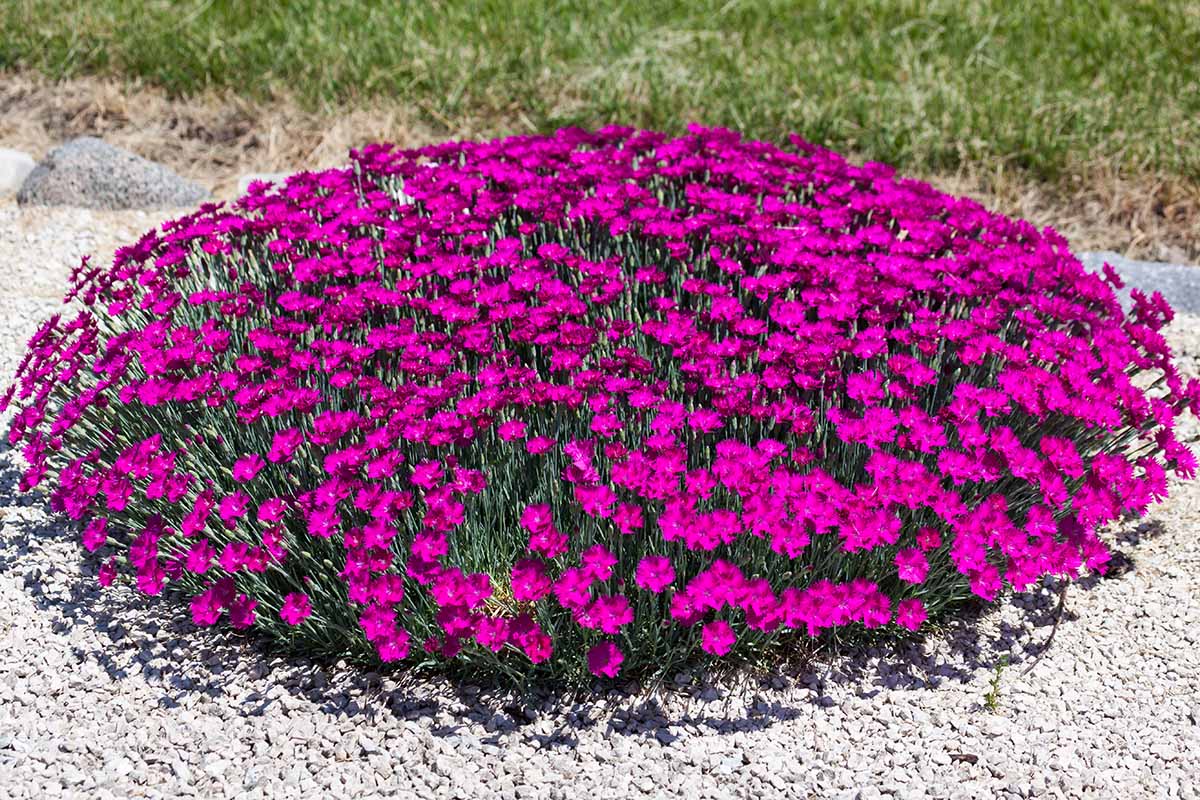
Plants are compact in size, growing to a height of four to eight inches with a spread of six to 12 inches. Flowers rise about four inches above the foliage.
Blooms may be single or double petaled with a lightly fringed margin and they come in vibrant shades of burgundy, cerise, fuchsia, mauve, pink, scarlet, and white. Many varieties also have bicolor variations, with contrasting eyes, rings, and spots.
The flowers are also fragrant, with the sweet, spicy scent of carnations.
Slender leaves are fine and grass-like, forming dense mats of beautiful, steel-blue foliage that remains evergreen.
Plants bloom prolifically in late spring to early summer and respond well to shearing after flowering, which encourages a light rebloom over summer.
Short-lived perennials, D. alpinus benefit from division every two to four years or when the centers start to die out.
Species plants are hardy in USDA Zones 3 to 9, hybrids vary.
Cultivation and History
D. alpinus is native to Europe, particularly the lime-rich, gritty soils of the eastern Austrian alps where it grows in rocky pockets, crevices, and high-altitude grasslands.
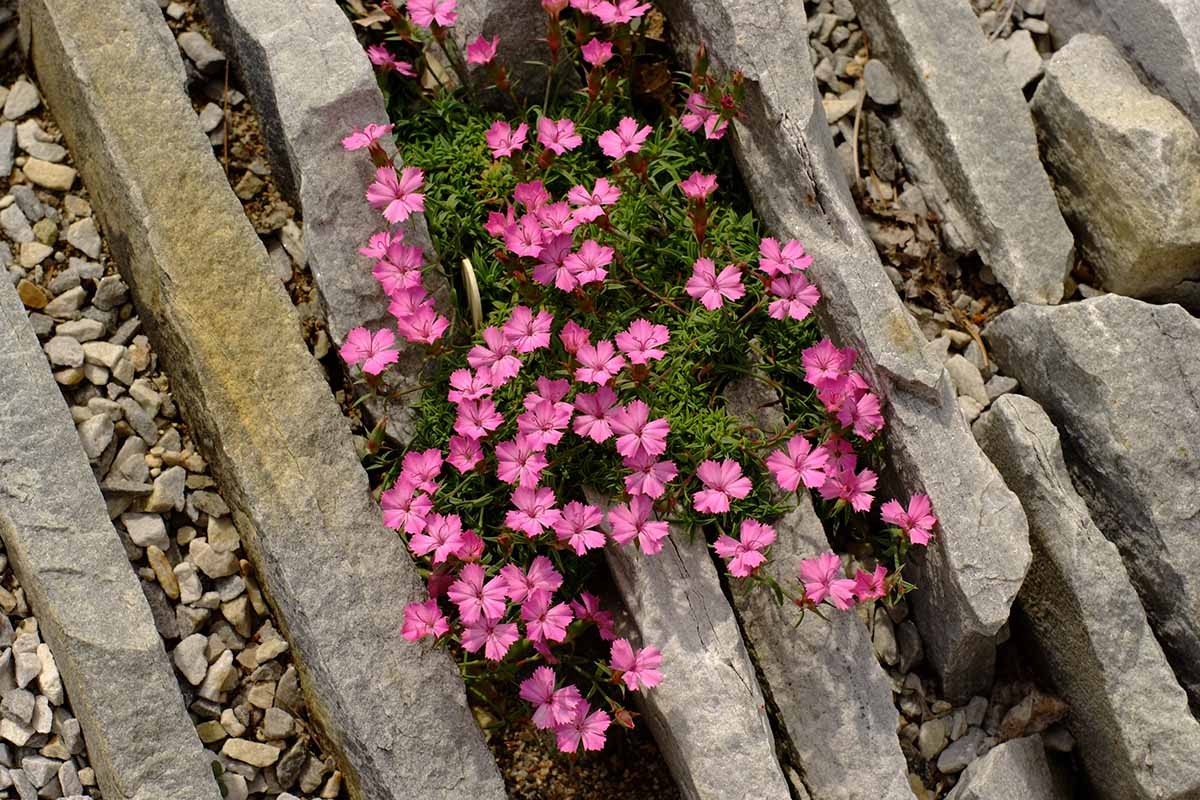
The species name alpinus and common name of alpine pinks refers to their subalpine habitat, growing in altitudes between 1700 feet and the timberline.
Exposed to the extreme cold, heat, and high levels of ultraviolet radiation at altitude, plants developed into tough and durable dwarf forms with excellent cold hardiness, as well as heat and drought resistance.
They’re also salt tolerant and make a good choice for seaside gardens or roadside beds exposed to salty winter slush.
Alpine pinks are one of a number of Dianthus species and cultivars that have received the esteemed RHS (Royal Horticultural Society) Award of Garden Merit.
D. alpinus should not be confused with D. x allwoodii, a cultivated hybrid also sometimes referred to as alpine pinks.
D. x allwoodii was bred in the early 20th century by English nurseryman Montague Allwood using D. plumarius and D. caryophyllus as parent plants.
Propagation
Perennial alpine pinks can be propagated by division, from seeds, and tip cuttings. However, most commercially available stock are hybrids and seeds saved from these plants may not grow true to the parent.
If you do have seeds from the species plant, our guide on how to plant and grow dianthus has the details for starting from seed.
By Division
Plants can be divided every two to four years or when the centers start to die back. Divide right after flowering in early summer or early fall.
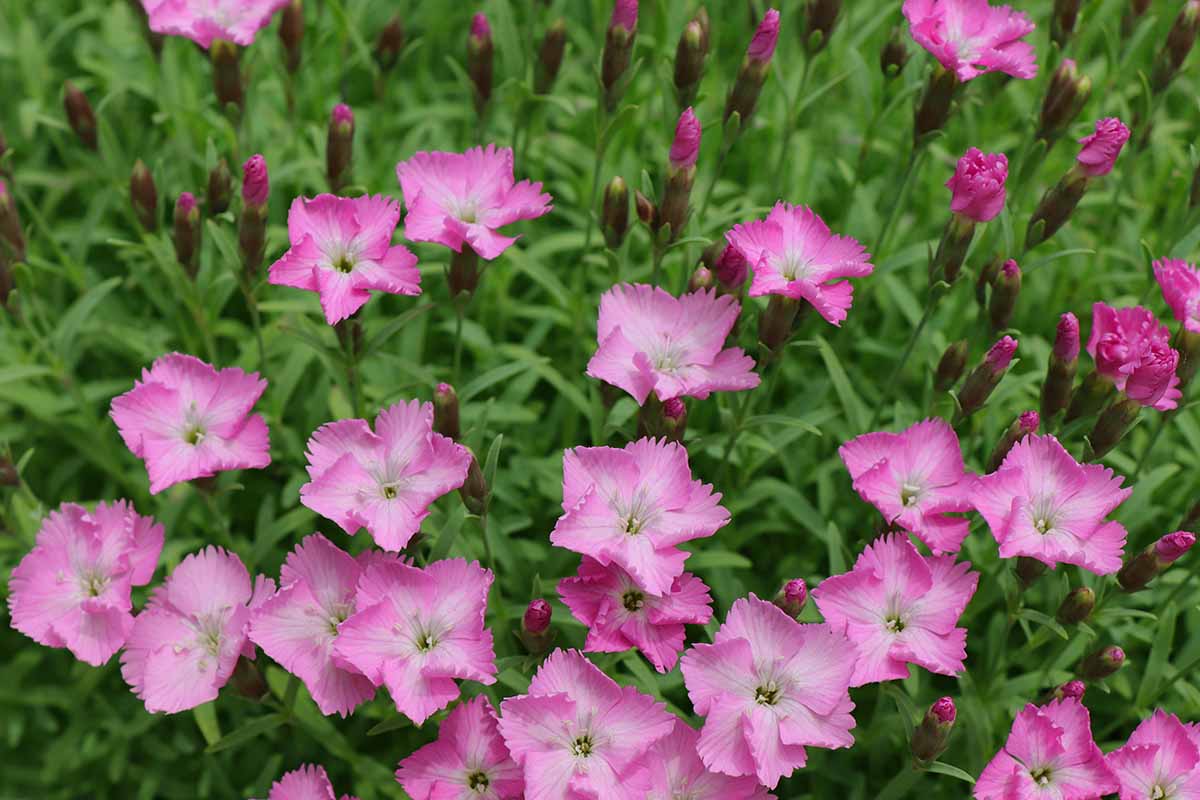
If the soil is dry, give plants a deep watering a day or two before division to make them easier to lift and split.
Fully insert a spade all the way around the plant’s perimeter, about two to four inches from the outside edges of the foliage.
Gently pry up the root ball and lift it out.
Using a sharp, sterile knife or garden saw, cut the root ball into equal sections such as halves or quarters, depending on the size. Carefully loosen the soil in each division with your fingers then shake gently to dislodge the excess.
Replant promptly to the same depth as the parent plant and water deeply.
Learn more about how to divide perennials in our guide.
From Tip Cuttings
Tip cuttings root fastest in summer and are best taken between June and September after plants have flowered.
Choose stems with no flower buds and take cuttings measuring two to three inches in length. Strip off the lower leaves and place stems in warm water to soak overnight.
The next day, dip cuttings into a rooting hormone powder, if desired, and insert stems into four- to six-inch pots filled with a moist, porous potting mix. Aim for three to four cuttings per pot.
Place pots in a sunny window or a sheltered garden location with dappled sunlight or light afternoon shade.
Keep the soil moist but not wet. Roots should form in three to four weeks, after which they can be transferred into larger, permanent pots or into the garden.
Summer cuttings flower the following year.
How to Grow
D. alpinus do best with a full sun location in humus-rich soil with a gritty texture and a pH of 6.0 to 7.5.
Plants can grow in lean soil but are most floriferous and spread more vigorously in enriched soils.
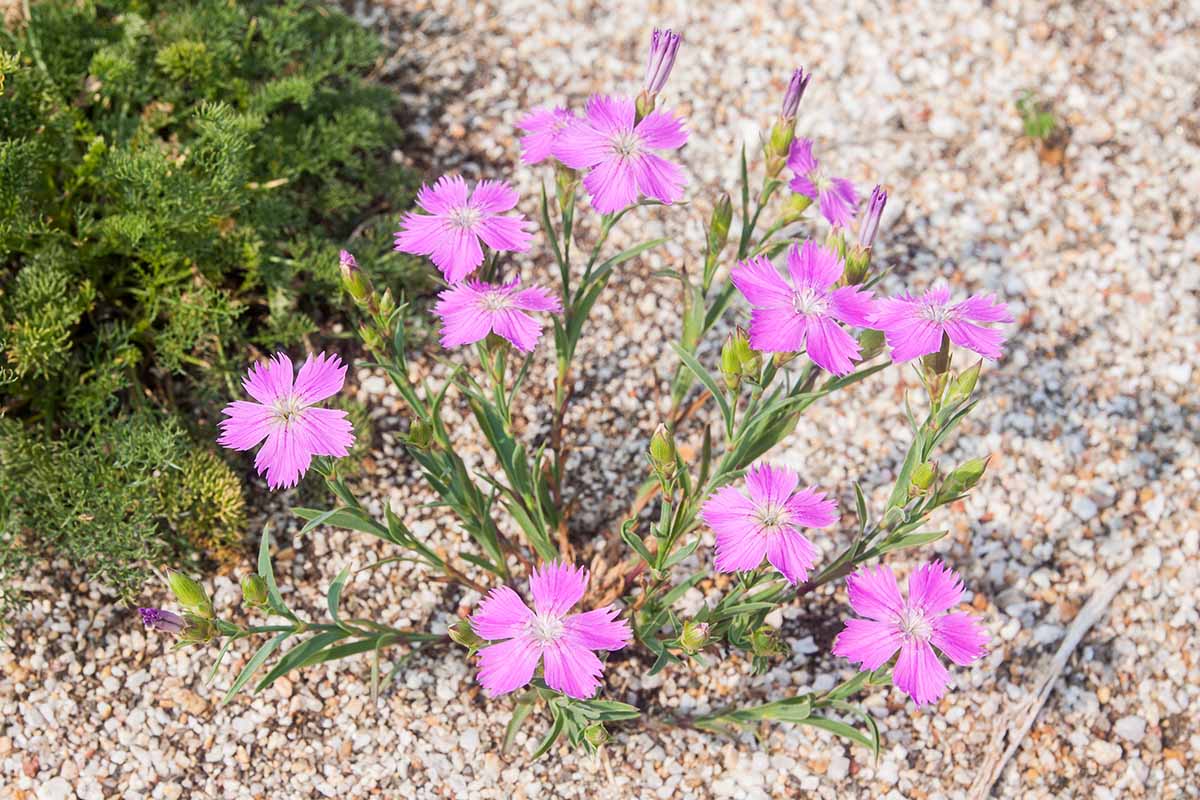
If needed, amend the soil by digging in two to four inches of organic matter like compost or well-rotted manure to a depth of six to eight inches.
Also, because dianthus are prone to root rot in poorly draining soil, I recommend mixing in a shovelful of landscape sand or pea gravel to ensure a free-draining environment.
Mix in some bone meal for healthy root growth and set crowns at, or slightly above soil level, spacing plants six to 12 inches apart.
Firm soil lightly and water gently. Provide about one inch of water per week, in the absence of rain, allowing the top of the soil to dry out between waterings.
For container cultivation, use well-draining soil amended with moisture-retentive materials such as coir, peat moss, perlite, or vermiculite and place pots in a full sun location.
Ensure plant crowns are planted at or slightly above the soil line. Remember that container soil tends to dry out faster than garden soil, so water regularly and allow the soil to dry slightly between waterings.
If cold weather is expected, give plants a two-inch mulch of pea gravel and tuck containers into a sheltered spot to overwinter.
Growing Tips
Alpine pinks are easy to cultivate and the following tips ensure abundant flowers:
- Plant in a full sun location.
- Provide organically-rich, well-draining soil.
- A mulch of sharp gravel provides winter protection, keeps roots cool in summer, and helps to deter pests like slugs and snails.
Pruning and Maintenance
Easy to cultivate, maintenance is straightforward as well.
D. alpinus forms beautiful cushions or mats of foliage and spreads laterally during the growing season.
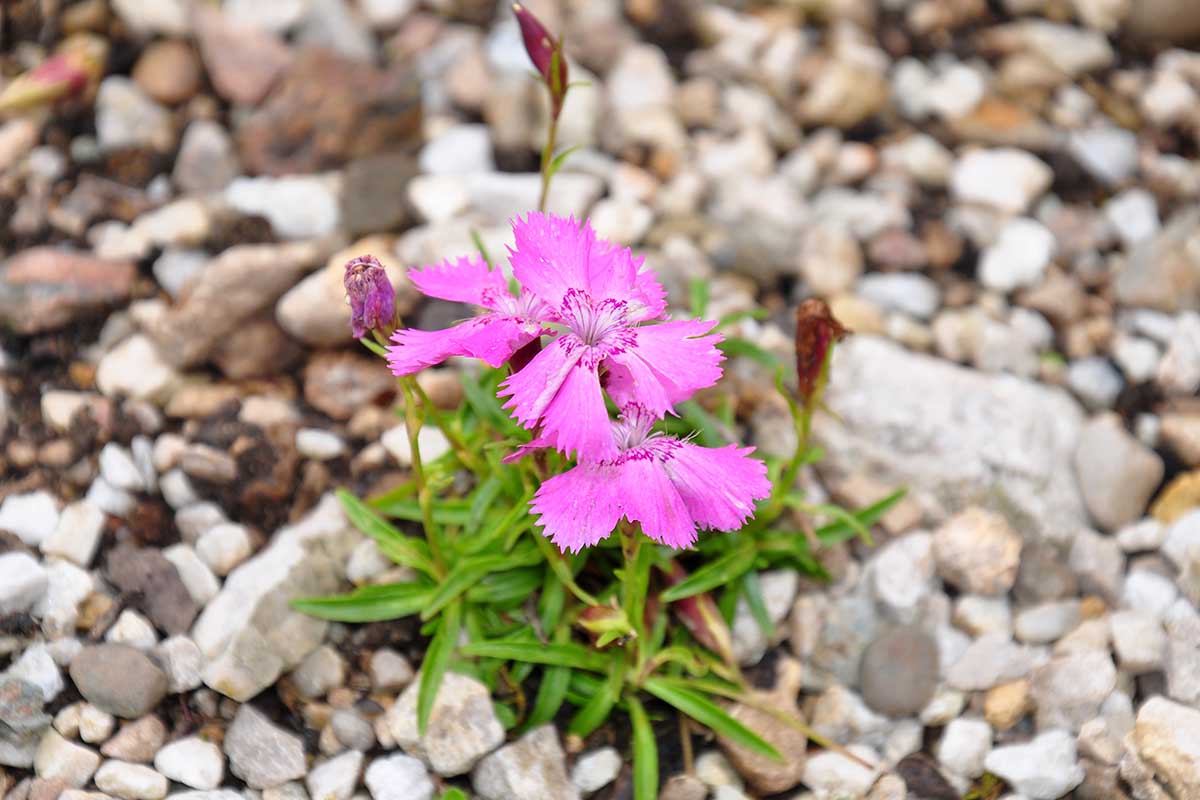
As short-lived perennials, they benefit from division every two to four years, or when the centers begin to die off. Divide as outlined in the Propagation section above.
Alpine pinks are light feeders and require little fertilizer. In spring after new growth emerges, feed with a balanced, slow-release fertilizer or apply a water soluble, all-purpose fertilizer after flowering.
Container plants are quickly depleted of nutrients and can be fed every four to six weeks with an all-purpose fertilizer.
After flowering, deadhead spent blooms or shear plants by up to one-third to encourage a lighter rebloom over summer.
Seeds ripen by late summer and can be collected from species plants in late July and August.
Collect seeds just as the dry pods open. Or bend the stems and shake out the seeds to help with self-sowing.
Prep for winter by cleaning away plant debris from the soil surface and removing any brown, damaged, or dead foliage.
To keep the foliage clean and roots well-drained in winter, use a mulch of pea gravel for cold protection. In areas of high rainfall avoid the use of heavy mulches like compost, which can trap excess moisture around the crown.
If a winter mulch is needed for cold protection, choose free-flowing materials like pea gravel and avoid the use of heavy, moisture-trapping materials.
For container-grown plants, remove saucers from under pots in areas with high rainfall to prevent roots from standing in water over winter.
Cultivars to Select
D. alpinus hybrids are popular and easily obtained online or in garden centers, but species plants and seeds can be a bit more elusive.
For true alpine stock, look to resources like the North American Rock Garden Society seed exchange.
Here’s a sampling of some popular cultivars:
Eastern Star
One of the Star™ series, ‘Eastern Star’ (aka ‘Red Dwarf’) features cherry red flowers with deep magenta eyes, light pink margins, and pretty, pink to white stamens.
The petal edges are lightly serrated and flowers have a deep fragrance of sweet cloves.
The delicate, gray-green foliage is semi-evergreen and forms dense, spreading cushions with a tight, compact habit that grows six to eight inches and spreads up to 12 inches. Hardy in Zones 5 to 8.
Container plants are available at Home Depot.
Fire Star
‘Fire Star’ (aka ‘Devon Xera’) displays masses of fringed, raspberry red flowers with a dark crimson eye in the late spring and early summer garden.
Flowers are highly fragrant with a sweetly spicy perfume of cloves and grow atop strongly branched stems.
The beautiful, silvery green foliage is semi-evergreen and grows in cushions or mats to a height of five to seven inches and spread eight to 12 inches.
Hardy in Zones 5 to 9.
Plants in #1 containers are available from Nature Hills Nursery.
Neon Star
‘Neon Star’ dazzles with compact mounds of stunning, iridescent single flowers of intense cerise with a burgundy eye and lightly toothed petals.
The narrow leaves of frosty foliage forms semi-evergreen, tidy cushions that grow to a mature height of six to eight inches with a spread of six to 12 inches.
Hardy in Zones 5 to 9.
Plants in two and a half quart containers are available at Home Depot.
Paint the Town Fuchsia
Dressed to impress, ‘Paint the Town Fuchsia’ is highly floriferous and features bright, fuchsia flowers with a lighter lavender eye and pretty, serrated petals.
Flowers have a spicy sweet fragrance and the fine-textured, glaucous leaves form uniform, evergreen mounds with a height of six to eight inches and a spread of 12 to 15 inches.
Hardy in Zones 4 to 9.
Plants in #1 containers are available at Nature Hills Nursery.
Peppermint Star
A bicolor beauty, ‘Peppermint Star’ (aka ‘Noreen’) produces clouds of hot pink, lightly serrated flowers with a magenta ring and pink throats.
This hybrid cultivar is semi-evergreen and forms attractive, dense clumps that grow six to eight inches tall and spread six to 12 inches.
Hardy in Zones 5 to 9.
Plants in #1 containers are available at Nature Hills Nursery.
Managing Pests and Disease
Today’s hybrids are often bred for enhanced disease resistance, but there are a few issues and pests to be aware of.
Sap-suckers like aphids and spider mites are the most likely insects to show up.
Easily controlled with a strong spray of water from the garden hose, more persistent infestations may require the use of neem oil or insecticidal soap.
In shady areas, slugs and snails can be a problem.
Create a natural barrier with the use of sharp gravel or diatomaceous earth to prevent access to creeping snails and slugs. And you can find more natural solutions in our guide on how to protect your garden from slugs and snails.
These plants are also susceptible to crown rot and cannot tolerate their roots in standing water or waterlogged conditions. Rot can be avoided by giving plants well-draining soil and placing the crowns at soil level or slightly above at planting time.
Rust sometimes appears in wet or hot and humid conditions. Deter rust by planting in well-draining soil and ensuring adequate spacing between plants for free-flowing air circulation.
Best Uses
Given their natural, rocky habitat, alpine pinks are a knockout in gravel and rock gardens, troughs, and screes with their delicate, glaucous foliage and brightly colored flowers.
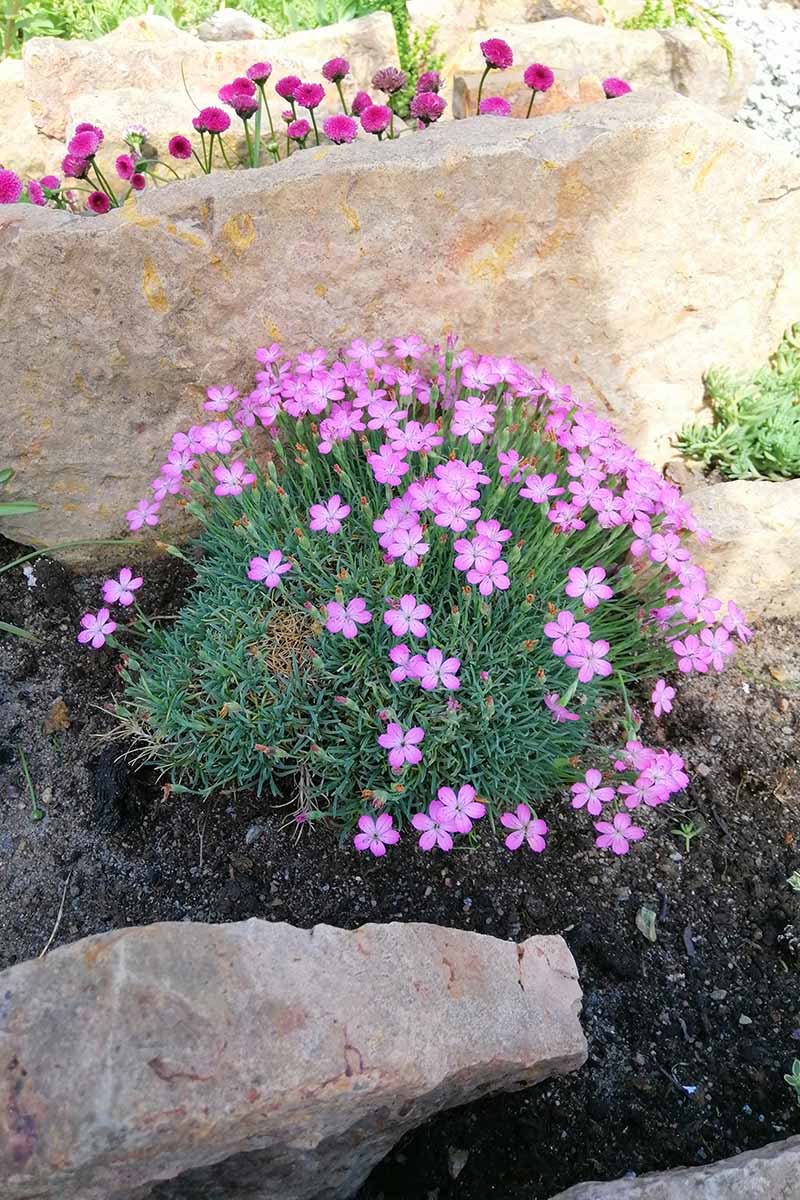
Mass planted, they spread and colonize, forming effective ground covers for banks and slopes.
A striking addition to raised beds, borders, patio pots, or window boxes and in a variety of themed settings including butterfly, cottage, courtyard, and cutting gardens.
Salt resistant, they’re also top performers in coastal gardens or roadside beds subject to salty snow and slush.
Quick Reference Growing Guide
| Plant Type: | Herbaceous perennial | Flower / Foliage Color: | Mauve, pink, red, white/glaucous green |
| Native to: | Austrian alps of central Europe | Tolerance: | Cold, deer, drought, heat, and salt |
| Hardiness (USDA Zone): | 3-9, hybrids vary | Maintenance: | Moderate |
| Season: | Late spring, reblooms in summer | Soil Type: | Humus rich with a gritty texture |
| Exposure: | Full sun | Soil pH: | 6.0-7.5 |
| Spacing: | 6-12 inches | Soil Drainage: | Well-draining |
| Planting Depth: | 1/8 inch (seeds), crown at soil level (transplants) | Attracts: | Bees, birds, and butterflies |
| Height: | 6-8 inches | Uses: | Beds, borders, containers, edging, groundcovers, rock gardens |
| Spread: | 6-15 inches | Family: | Caryophyllaceae |
| Water Needs: | Moderate | Genus: | Dianthus |
| Common Pests and Diseases: | Aphids, slugs, snails, spider mites; crown rot, rust | Species: | Alpinus |
Rock Gardens and Much More
Colorful, fragrant, and robust, alpine pinks are wonderfully versatile and make an attractive addition to numerous settings, not just the rock garden!
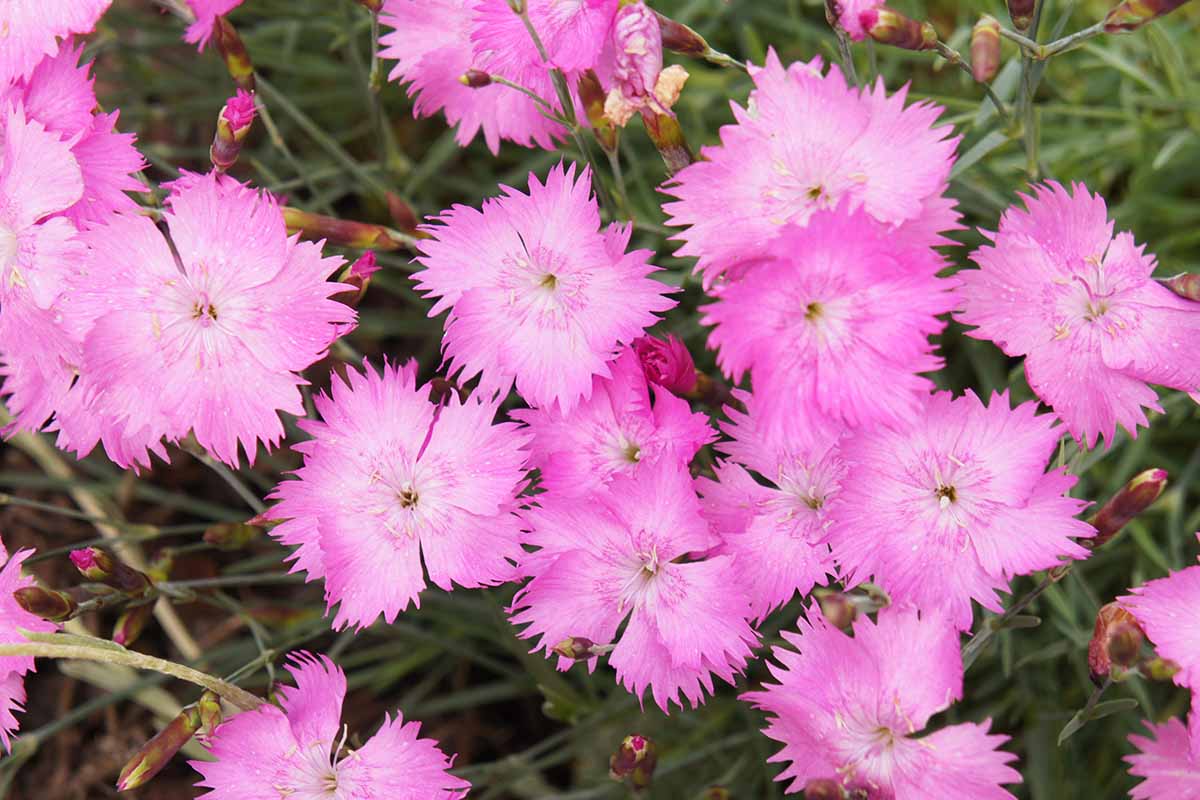
Be sure to plant plenty where the lovely fragrance can be enjoyed, like flanking entryways, garden paths, and sidewalks or in patio pots and window boxes.
Have you got a favorite place for alpine pinks in the garden? Let us know in the comments section below.
And for more dianthus know-how, add these guides to your reading list next:


